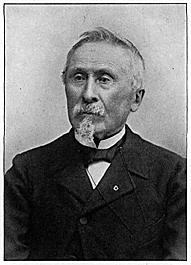
Syringa is a genus of 12 currently recognized species of flowering woody plants in the olive family or Oleaceae called lilacs. These lilacs are native to woodland and scrub from southeastern Europe to eastern Asia, and widely and commonly cultivated in temperate areas elsewhere.
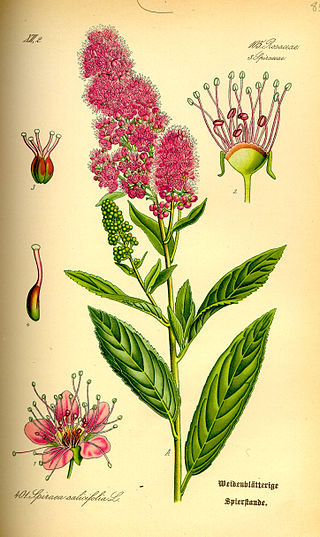
Spiraea, sometimes spelled spirea in common names, and commonly known as meadowsweets or steeplebushes, is a genus of about 80 to 100 species of shrubs in the family Rosaceae. They are native to the temperate Northern Hemisphere, with the greatest diversity in eastern Asia.

Commonly known as hellebores, the Eurasian genus Helleborus consists of approximately 20 species of herbaceous or evergreen perennial flowering plants in the family Ranunculaceae, within which it gave its name to the tribe of Helleboreae. Despite names such as "winter rose", "Christmas rose" and "Lenten rose", hellebores are not closely related to the rose family (Rosaceae). Many hellebore species are poisonous.

Syringa vulgaris, the lilac or common lilac, is a species of flowering plant in the olive family Oleaceae, native to the Balkan Peninsula, where it grows on rocky hills. Grown in spring for its scented flowers, this large shrub or small tree is widely cultivated and has been naturalized in parts of Europe, Asia and North America. It is not regarded as an aggressive species. It is found in the wild in widely scattered sites, usually in the vicinity of past or present human habitations.

Lilacia Park, an 8.5-acre (3.4 ha) garden, is located at 150 South Park Avenue, Lombard, Illinois. It is adjacent to the Lombard station. It specializes in lilacs and tulips. It is open to the public daily.

Delme is a commune in the Moselle department in Grand Est in north-eastern France. It was the center of the former canton of Delme until 2015. It had a population of 1,148 in 2019.

The hybrid elm cultivar Ulmus × hollandica 'Wredei', also known as Ulmus × hollandica 'Dampieri Aurea' and sometimes marketed as Golden Elm, originated as a sport of the cultivar 'Dampieri' at the Alt-Geltow Arboretum, near Potsdam, Germany, in 1875.

Ceanothus arboreus is a species of perennial shrub to small tree in the family Rhamnaceae, commonly known as the feltleaf ceanothus, island ceanothus, and island mountain lilac. It is the largest member of the California lilacs, and is characterized with glossy, dark green foliage that is adorned by pale blue to white flowers in bloom. It is endemic to the Channel Islands of California and Guadalupe Island in Mexico, only being re-discovered on Guadalupe Island after the elimination of feral goats.
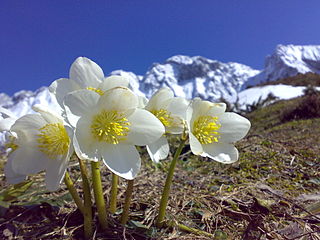
Helleborus niger, commonly called Christmas rose or black hellebore, is an evergreen perennial flowering plant in the buttercup family, Ranunculaceae. It is poisonous.

Louis Benoît van Houtte was a Belgian horticulturist who was with the Jardin Botanique de Brussels between 1836 and 1838 and is best known for the journal Flore des Serres et des Jardins de l'Europe, produced with Charles Lemaire and M. Scheidweiler, an extensive work boasting more than 2,000 coloured plates in 23 volumes published between 1845 and 1883.

"Double-flowered" describes varieties of flowers with extra petals, often containing flowers within flowers. The double-flowered trait is often noted alongside the scientific name with the abbreviation fl. pl.. The first abnormality to be documented in flowers, double flowers are popular varieties of many commercial flower types, including roses, camellias and carnations. In some double-flowered varieties all of the reproductive organs are converted to petals — as a result, they are sexually sterile and must be propagated through cuttings. Many double-flowered plants have little wildlife value as access to the nectaries is typically blocked by the mutation.

Crocosmia × crocosmiiflora, montbretia, is a garden hybrid of C. aurea and C. pottsii, first bred in 1880 in France by Victor Lemoine. The basionym of the hybrid is Montbretia crocosmiiflora Lemoine. In 1932 it was reclassified as C. × crocosmiiflora (Lemoine) N .E.Br., but the common name "montbretia" is still often found in horticultural literature, and is commonly used in the British Isles for orange-flowered cultivars that have naturalised, while "crocosmia" is reserved for less aggressive red-flowered cultivars.

Paeonia × suffruticosa is a name used for a group of cultivars of tree peonies that are the result of hybridisation with species exclusively belonging to the subsection Vaginatae. The common name used in China is mǔdān. Plants belonging to this group have been cultivated for millennia in China, initially only as a source of traditional Chinese medicine particularly the skin of its roots. Already early on the plant was also cultivated for its ornamental value, and it is highly revered in Chinese culture.
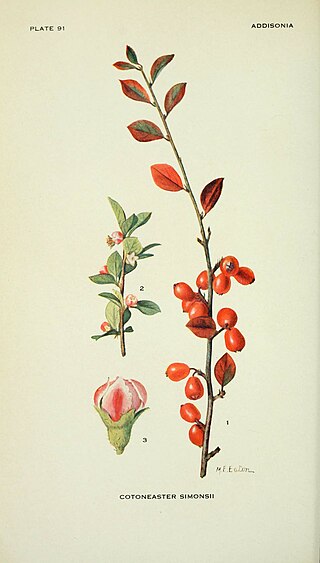
Cotoneaster simonsii, the Himalyan cotoneaster, is a species of flowering plant in the family Rosaceae. It is native to Nepal, the eastern Himalayas, Assam, and Myanmar, and has been introduced to a number of locales in Europe, the west coast of North America, and Australia as a garden escapee. The Royal Horticultural Society considers it to be an undesirable invasive non-native species.
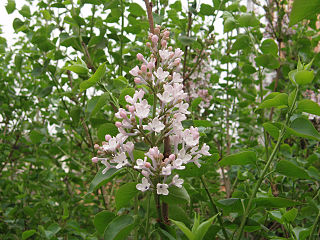
Syringa oblata is a species in the genus Syringa, in the family Oleaceae. It is also known as early blooming lilac or broadleaf lilac.
Isabella Preston was a horticulturist and public servant widely recognized for her achievements in plant hybridization and extensive work in ornamental plant breeding. She is Canada’s first female professional plant breeder. During her 26-year career, she produced nearly 200 new hardy hybrids of lily, lilac, crab apple, iris and rose plants for Canada's cold climate. While female plant breeders were rather rare in her day, she quietly challenged gender bias and set the stage for new generations of breeding programs at the Central Experimental Farm in Ottawa, Ontario, Canada and elsewhere.

Rosa 'Albertine' is a salmon-pink hybrid wichurana, a large-flowered rambling rose that blooms in clusters once a year. The cultivar was bred by René Barbier before 1921 and introduced into Australia by Hazlewood Bros. Pty. Ltd. in 1923 as "Albertine". It has been awarded the Award of Garden Merit (AGM) by the Royal National Rose Society (RNRS) in 1993.

Rosa 'Paul Transon' is a salmon-pink hybrid wichurana. The cultivar was bred by French rose hybridizer, René Barbier in 1900. The rose was awarded the Award of Garden Merit (AGM) by the Royal National Rose Society (RNRS) in 1993.
